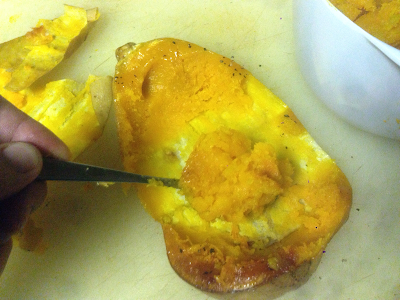This is a super easy and delicious soup made from the part of the asparagus that most people throw away, the end cuts. In the photo, I have garnished the soup with some sautéed asparagus, but this is not necessary. The cream soup stands on its own, without garnish. This means you can prepare the asparagus, as shown, and serve them as a side dish to your main course, such as a pan seared filet mignon with sauce hollandaise, while the soup becomes a course of its own. So you get two dishes for a little more than the price of one.
You can use this recipe as a base for many other cream soups. For example, change asparagus to crab, the white wine to sherry, and add some ½'ed lemons and Old Bay, you'll have crab bisque. Make lobster stock (from lobster shells) instead of asparagus stock and you'll get lobster bisque. Same goes for crawfish. Add creamed corn, PEI Mussels, spinach, and curry powder you get one heck of a good chowder. You can make a mushroom stock, leaving the mushroom bits in, then make the cream soup, over-thickening it a bit, and use it to make green bean casserole. The sky and your imagination are the limit.
Note: It is important to realize that these recipes are merely guidelines to follow. They'll taste great as they are, but I encourage you to play with them and make the recipes your own.
Note: It is good practice to read the entire recipe, while paying particular attention to the "Notes", before you try to make the dish, as there are often subtleties that can be easily overlooked, which sometimes, can make all the difference in the world for the outcome.
Serves 4
Skill Level: Beginner
Prep time about 10 minutes.
Cook Time about 30 minutes.
Ingredients:
- 1 Bunch Asparagus
- 3 cloves garlic, minced.
- ½ cup Chicken Stock
- ½ cup White Wine
- 2 cups Almond Milk
- 1 Pint Heavy Whipping Cream
- 1 Tbls butter
- Arrow Root (Corn starch can be used, but not recommended)
- Kosher Salt
- Pepper
- White Wine
- Extra virgin olive oil
Tools Needed:
- Paring Knife
- Saucepan
- Mesh Strainer
- Cutting Board
 First, determine where the asparagus are the juiciest. To do this, simply bend the stalk until it breaks. It is from that point, upwards the asparagus is the juiciest, and from that point and below, the driest and most fibrous. These dry, fibrous ends are the focus of this recipe. Cooking the tips is simply a matter of blanching in boiling, salted water, then shocking in ice water, then sautéing in butter with salt and pepper to taste.
First, determine where the asparagus are the juiciest. To do this, simply bend the stalk until it breaks. It is from that point, upwards the asparagus is the juiciest, and from that point and below, the driest and most fibrous. These dry, fibrous ends are the focus of this recipe. Cooking the tips is simply a matter of blanching in boiling, salted water, then shocking in ice water, then sautéing in butter with salt and pepper to taste.Using a paring knife, at about an inch above the break point we just found, begin making tapered cuts right up to the break point. When you have gone all the way around, simply bend and snap it off.
Note: Cutting asparagus in this manner is just for appearance.
This is the scrap pile that would normally be tossed away, well we're going to make a great soup out of it.
Sauté the asparagus, with the minced garlic in a few tablespoons of olive oil.

Deglaze with white wine and chicken stock.
Note: Stocks can be used as the foundation to other stocks. In particular, it is common to make a stock, then re-boil the stock constituence, making a second, thinner stock known as a remouillage or "remi" for short. A remi is a type of stock specifically used as the base for the next stock prepared. Doing so, insures no flavor is lost or wasted.
Once the wine and stock have reduced by 70-75%, add the Almond milk and then the heavy cream
 |
| After simmering with stock in the cream for 20 minutes, strain through a mesh strainer. |
Note: The reason corn starch is not recommended, is due to the fact it is unstable. By unstable, I mean that if you reheat something thickened with cornstarch 2 or 3 times, the corn starch will completely loose its ability to thicken. Arrow Root, on the other hand, is a sable starch and therefore can withstand unlimited rehearings without losing its thickening property.
Note: If the soup becomes over-thickened, then simply thin down by adding water, or stock, little-by-little, until the the soup reaches the desired thickness. Then, re-adjust the flavor with salt and pepper.
Fun Fact: Soup can be maintained indefinitely, if brought to a boil at least once a day. In Jamaica, there is a soup tradition known as a "Pepper Pot", whereby a family keeps a soup based meal going continuously for decades, and in some cases, more than a century.
Enjoy.






















































